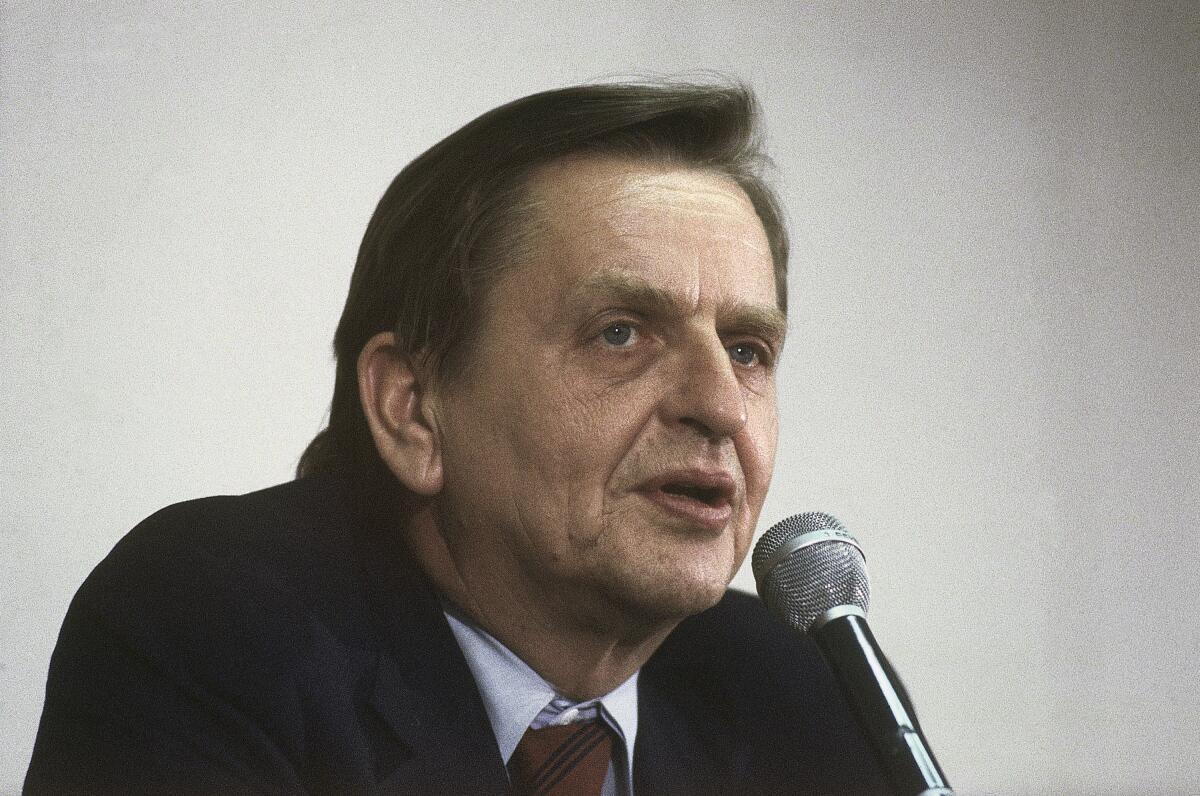34 years later, Sweden drops investigation into assassination of Prime Minister Olof Palme

- Share via
STOCKHOLM — Sweden on Wednesday dropped its investigation into the unsolved murder of former Prime Minister Olof Palme, saying that the decision was made because the main suspect in one of the world’s most famous cold cases died in 2000.
Palme was gunned down Feb. 28, 1986, after he and his wife, Lisbet, left a movie theater in downtown Stockholm. The murder shocked the nation and shook its image as being so safe and peaceful that politicians could wander around in public without protection.
More than 100 people have been suspected in the crime, and the unsolved case has generated scores of conspiracy theories, with possible villains including foreign governments, rogue Swedish police with right-wing sympathies or a lone shooter.
The investigation is being closed because the main suspect, Stig Engstrom, died in 2000, the case’s chief prosecutor, Krister Petersson, told a news conference in Stockholm on Wednesday.
“Stig Engstrom is deceased, and therefore I am not able to start proceedings or even interview him. That is why I decided to discontinue the investigation,” Petersson told reporters. “Since he has died, I cannot indict him.”
Hans Melander, head of the investigation, said that 134 people had confessed to the murder — 29 directly to the police — and some 10,000 people had been questioned during the 34-year probe.
“I am completely convinced that there are other people who believe in other solutions, but as Krister says, this is what we came up with and believe in,” Melander said.
Swedish Prime Minister Olof Palme was shot on a city street and died at a hospital Friday night, Finance Minister Kjell-Olof Feldt said Saturday.
Marten Palme, the son of Olof and Lisbet Palme, told Swedish radio that “I also think Engstrom is the perpetrator.”
“The fact that a country’s prime minister was murdered is a national trauma. I now have a hope that the wound can heal,” Swedish Prime Minister Stefan Lofven, a Social Democrat like Palme, told a later news conference Wednesday. “A thorough work has been carried out by the prosecutors and they have gone to the bottom of it. ... The best thing would have, of course, been through a conviction.”
Deputy Prime Minister Isabella Lovin of the small Green Party said the unsolved killing “is still a wound” in Sweden.
Palme, who cut a flamboyant, even boyish figure, had sought to live as ordinary a life as possible and would often go out without bodyguards. On the night of the murder he had no protection.
The horrible suddenness of Olof Palme’s death meant that the obituaries in the American press were hastily assembled, and more one-dimensional than usual.
The prime minister had an aristocratic background but was known for his left-leaning views and was eyed with suspicion in conservative circles and by the United States. Among Swedes and in the Nordic region, Palme was a divisive figure, both loved and despised.
At the time of the slaying, the 52-year-old Engstrom was reportedly one of the first people at the murder scene and was briefly considered a possible suspect. He had a military background, was a member of a shooting club, often worked late and had a drinking problem, Petersson said. Also known as the Skandiamannen because he worked in the nearby Skandia insurance company, Engstrom had a strong dislike of Palme and his policies.
Yet Engstrom’s actions on the night of the murder are unclear. Several witnesses gave descriptions of the fleeing killer that matched Engstrom, while others said he wasn’t even at the scene. Engstrom himself claimed to have been present from the beginning, and said he spoke to Lisbet Palme and police and attempted to resuscitate the dying premier.
Soon after the murder, Engstrom appeared in Swedish media and developed an increasingly detailed story of his involvement in the events that night, even criticizing the police investigation. He claimed witnesses who had described the killer had, in fact, been describing him as he was running to catch up with police officers in pursuit of the assassin.
Buffeted by an icy north wind, a single blood-red rose stood in a jar to mark the spot along Stockholm’s busiest thoroughfare where so many still stop and stare.
The police then labeled Engstrom as an unreliable and inconsistent witness and classified him as a person of no interest to the investigation.
Lisbet Palme was injured in the attack and later identified the shooter as Christer Pettersson, an alcoholic and drug addict who was convicted of Palme’s murder. The sentence was later overturned after police failed to produce any technical evidence against him, leaving the murder an unsolved mystery. Pettersson died in 2004.
Immediately after Palme was killed, thousands of Swedes flooded the scene of his death with red roses, a symbol of his Social Democratic Party, building a 3-foot-tall wall of flowers.
Another, later echo of Sweden’s lost innocence came in 2003, when Foreign Minister Anna Lindh was stabbed to death in a Stockholm department store, also not protected by bodyguards. In 2004, Mijailo Mijailovic, who confessed to the fatal stabbing, was convicted of murder and sentenced to be confined in psychiatric care.
More to Read
Sign up for Essential California
The most important California stories and recommendations in your inbox every morning.
You may occasionally receive promotional content from the Los Angeles Times.










